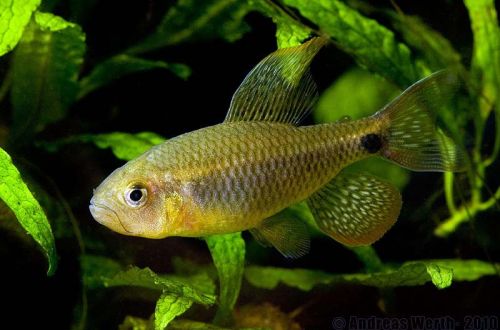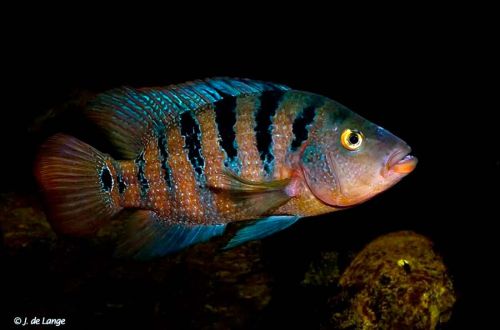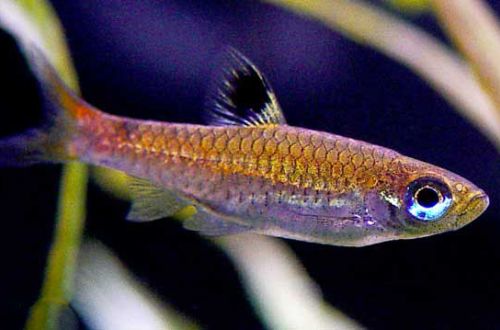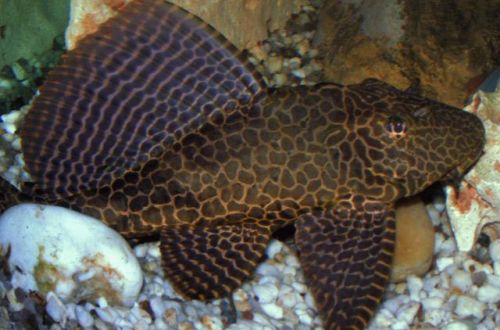
Crenuchus tulle
Crenuchus tulle, scientific name Crenuchus spilurus, belongs to the Crenuchidae family. The original beautiful fish, unlike most characins, this species has clearly expressed sexual dimorphism and well-developed parental instincts. It is a miniature predator, but despite this it is very friendly.

Contents
Habitat
Initially, it was believed that it occurs exclusively in the Essequibo River basin (Eng. Essequibo) – the largest river in Guyana (South America). However, it was later found throughout the Amazon and Orinoco basins, as well as in numerous coastal rivers in French Guiana and Suriname. It lives in rivers, streams and channels flowing among tropical rainforests, it can often be found in flooded forest areas during high water periods.
Brief information:
- The volume of the aquarium – from 90 liters.
- Temperature – 20-28°C
- Value pH — 4.0–6.5
- Water hardness – soft (1-5 dGH)
- Substrate type – any sandy
- Lighting – subdued
- Brackish water – no
- Water movement is weak
- The size of the fish is up to 7 cm.
- Food – meat
- Temperament – conditionally peaceful, carnivorous species
- Keeping in a group with one male and several females
Description
Adult individuals reach a length of no more than 7 cm. Males, in comparison with females, are much larger and brighter, have large dorsal and anal fins. The color is dark – gray, brown, brownish; varies by region of origin. There is a large black dot at the base of the tail.
Food
A carnivorous species, in nature they feed on tiny invertebrates and other zooplankton. In a home aquarium, live or frozen food should be fed, such as brine shrimp, daphnia, bloodworms, moina, grindal worms, etc. They can eat small fish on occasion.
Maintenance and care, arrangement of the aquarium
The minimum tank size starts from 90 liters. In the design, a sandy substrate is used, shelters are formed from artificial or natural snags, branches of tree fragments. The lighting is subdued, in accordance with which shade-loving and unpretentious plants or ferns, mosses are selected. Floating vegetation will serve as an additional means of shading the aquarium.
In the natural habitat of Krenuchus, the tulle beds of rivers and streams are usually littered with numerous foliage and branches of trees and shrubs. To simulate similar conditions, you can place leaves or cones of deciduous trees on the bottom of the aquarium. In the process of their decomposition, the water turns into a characteristic light brown color. It is worth noting that the leaves are pre-dried and soaked for several days until they begin to sink and only then are immersed in the aquarium. Update once a week.
Water conditions should have acidic pH values with very low carbonate hardness (dGH), with an acceptable temperature range of 20-28°C. Timely clean the substrate from organic waste (food remains and excrement), and also update part of the water (15–20% of the volume) with fresh water weekly.
Behavior and Compatibility
Despite the status of a predator, this species has a rather peaceful and even timid disposition, however, everything changes if it meets a very small fish. The latter will quickly become his dinner.
During the mating season, the behavior changes to aggressive, Krenukhus tulle chooses a territory and fiercely guards it from potential competitors. Usually everything ends with a demonstration of strength and it does not come to skirmishes. Active and larger neighbors are generally safe, rather they will intimidate him.
It is recommended to keep in a species aquarium in a small group – a male and several females, or in company with some callicht or chain catfish.
Breeding / breeding
They spawn in caves or among fallen leaves, during the mating season they form temporary pairs. The male guards the eggs until the fry appear.
Breeding is possible in a common aquarium if there are no other fish species in it. Under favorable conditions, the male chooses a territory in the center of which there is a pile of leaves or a cave, for example, in the form of a decorative sunken ship, a castle, etc., where he persistently invites the female. In the case of a cave, the eggs are attached to the inner dome, the male remains to protect future offspring, the female swims away and no longer shows interest in laying.
The fry appear after 36-48 hours, and within a week they will swim freely in search of food. At this point, the male’s parental instincts will begin to fade. The juveniles should be transferred to a separate tank filled with water from the main tank and adjusted to the housing requirements. An important point is that it is advisable to use a simple sponge airlift or bottom filter as a filtration system in order to avoid accidentally sucking fry into the filtration system. Feed with specialized micro food.
Fish diseases
The main reason for the vast majority of the health problems of Crenuchus tulle is unsuitable housing conditions and poor nutrition. If the first symptoms of any disease appear, first of all check the condition and quality of the water, if necessary, bring the values back to normal and only then proceed with treatment.





